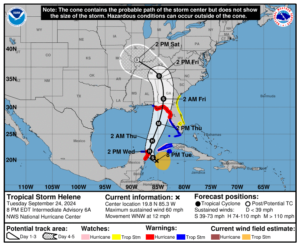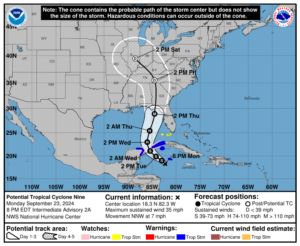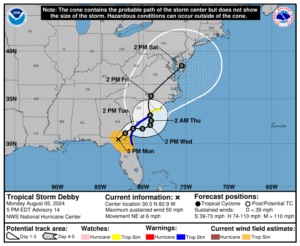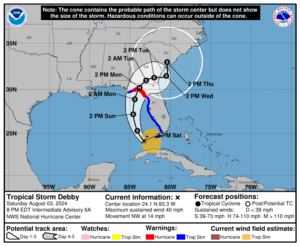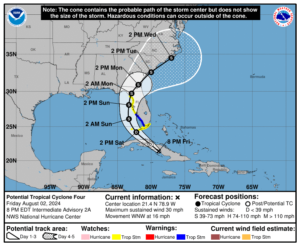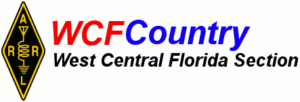WCF SECTION SPECIAL BULLETIN #24-06 – 2000 EDT – 9/24/24
TROPICAL STORM HELENE – 2000 EDT – 9/24/24
Potential Tropical Cyclone Nine was declared a “full fledged” tropical cyclone this morning in the 1100 EDT advisory, and went from straight from a potential tropical cyclone to a tropical storm. The forecast track has changed very little since yesterday. Right before the center enters the Gulf of Mexico on early Wednesday morning, Helene is forecast to intensify into a Category 1 hurricane. Helene is forecast to continue this intensification, until it becomes a Category 3 hurricane, a major hurricane, on early Thursday morning before making landfall in the eastern Florida panhandle by Thursday evening near sunset. In other words, the energy available for this storm to tap is essentially “rocket fuel.” Storms that enter the Gulf of Mexico often intensify very quickly, due to the high water temperature and low shear levels. Helene once it reaches about 25 degrees in latitude is expect to “hit the accelerator” and increase in forward speed to around 20 mph, continuing this speed and increasing even slightly more after landfall, due to traveling in the area between a low pressure area to the west and high pressure to the east.
COASTAL WATCHES/WARNINGS AND FORECAST CONE FOR STORM CENTER
SUMMARY OF 2000 EST…0000 UTC…INFORMATION
——————————————————————————-
LOCATION…19.8N 85.3W
ABOUT 115 MI…185 KM ESE OF COZUMEL MEXICO
ABOUT 145 MI…235 KM S OF THE WESTERN TIP OF CUBA
MAXIMUM SUSTAINED WINDS…60 MPH…95 KM/H
PRESENT MOVEMENT…WNW OR 300 DEGREES AT 12 MPH…19 KM/H
MINIMUM CENTRAL PRESSURE…991 MB…29.26 INCHES
SUMMARY OF WATCHES AND WARNINGS IN EFFECT:
A Storm Surge Warning is in effect for…
* Indian Pass southward to Flamingo
* Tampa Bay
* Charlotte Harbor
A Hurricane Warning is in effect for…
* Anclote River to Mexico Beach, Florida
* Cabo Catoche to Tulum, Mexico
A Hurricane Watch is in effect for…
* Cuban province of Pinar del Rio
* Englewood to Anclote River, including Tampa Bay
A Tropical Storm Warning is in effect for…
* Dry Tortugas
* Lower and Middle Florida Keys west of the Channel 5 Bridge
* Flamingo to Anclote River, including Tampa Bay
* West of Mexico Beach to the Walton/Bay County Line
* Rio Lagartos to Cabo Catoche, Mexico
* Cuban provinces of Artemisa, Pinar del Rio, and the Isle of Youth
A Tropical Storm Watch is in effect for…
* Lake Okeechobee
* Palm Beach/Martin County Line northward to the Savannah River
A Storm Surge Warning means there is a danger of life-threatening inundation, from rising water moving inland from the coastline, during the next 36 hours in the indicated locations. For a depiction of areas at risk, please see the National Weather Service Storm Surge Watch/Warning Graphic, available at hurricanes.gov. This is a life-threatening situation. Persons located within these areas should take all necessary actions to protect life and property from rising water and the potential for other dangerous conditions. Promptly follow evacuation and other instructions from local officials.
A Hurricane Warning means that hurricane conditions are expected somewhere within the warning area. A warning is typically issued 36 hours before the anticipated first occurrence of tropical-storm-force winds, conditions that make outside preparations difficult or dangerous. Preparations to protect life and property should be rushed to completion.
A Tropical Storm Warning means that tropical storm conditions are expected somewhere within the warning area within the next 36 hours.
A Hurricane Watch means that hurricane conditions are possible within the watch area. A watch is typically issued 48 hours before the anticipated first occurrence of tropical-storm-force winds, conditions that make outside preparations difficult or dangerous.
A Tropical Storm Watch means that tropical storm conditions are possible within the watch area.
FORECAST DISCUSSION:
The following excerpt is from the Forecast Discussion issued at 1700 EDT today:
“Deep convection is gradually filling in within Helene’s circulation, and the well-defined center that formed earlier this morning is now obscured by cloudiness and showers. Data from NOAA buoy indicate that the central pressure has fallen to 995 mb, and the initial intensity is therefore estimated to be 45 kt. NOAA and the Air Force Reserve Hurricane Hunters will be investigating Helene this evening to provide more information about the storm’s intensity and structure.
With the center formation this morning, Helene has taken a short-term jog to the west-northwest (300/10 kt). The storm is expected to turn northwestward by tonight and then northward on Wednesday as high pressure over Florida shifts eastward, and a deep-layer trough digs southward over the Lower Mississippi Valley. The NHC track forecast has been shifted westward during the first 24 hours to account for the recent motion, and Helene’s center could get very close to the northeastern coast of the Yucatan Peninsula Wednesday morning. After that time, however, the NHC track forecast is relatively unchanged from the previous prediction, except for being a little bit slower based on the latest guidance. Helene is expected to accelerate while it moves northward across the eastern Gulf of Mexico and approaches the Florida Gulf coast.
Warm sea surface temperatures, decreasing shear, and strong upper-level divergence are likely to foster Helene’s strengthening while it moves across the northwestern Caribbean Sea and eastern Gulf of Mexico. The statistical-dynamical SHIPS/LGEM models, as well as the regional hurricane models, continue to show Helene reaching major hurricane intensity while over the eastern Gulf of Mexico, and that continues to be shown in the NHC forecast. Helene could maintain that level of intensity until it reaches the Gulf coast of Florida.
Of equal importance to the forecast intensity is Helene’s forecast size. Helene’s forecast radii are at the 90th percentile of major hurricane size at similar latitudes, and therefore storm surge, wind, and rainfall impacts will likely extend well away from the center and outside the forecast cone, particularly on the east side. In addition, the fast forward speed while it crosses the coast will likely result in farther inland penetration of strong winds over parts of the southeastern United States after landfall.”
SITUATION AND ACTIONS:
Much has changed since yesterday as expected. Here is the summary of the watches and warnings issued by the National Hurricane Center and the National Weather Service Office in Ruskin for the ARRL West Central Florida Section:
- A Hurricane Warning is in effect for Coastal Pasco County.
- A Tropical Storm Warning and a Hurricane Watch are both in effect for the following ARRL West Central Florida Section counties: Inland Pasco, Pinellas, Coastal Hillsborough, Coastal Manatee, Coastal Sarasota.
- A Tropical Storm Warning is in effect for for the following ARRL West Central Florida Section counties: Inland Pasco, Pinellas, Inland Hillsborough, Inland Manatee, Inland Sarasota, and Charlotte.
- A Storm Surge Warning is in effect for the following ARRL West Central Florida Section counties: Coastal Pasco, Pinellas, Coastal Hillsborough, Coastal Manatee, Coastal Sarasota, and Coastal Charlotte.
- A Flood Watch is also in effect for all counties in the ARRL West Central Florida Section through Friday morning.
In anticipation of the arrival of what will become Hurricane Helene, Florida Governor Ron Desantis signed Executive Order 24-209, which amended his previous executive order, Executive ORder . The number of Florida counties included in this declaration went from 41 to 61 counties. All counties in the ARRL West Central Florida Section are now under a declared state of emergency. For the full text of Executive Order 24-209 go to https://www.flgov.com/2024/09/24/memorandum-executive-order-number-24-209-emergency-management-amending-execuive-order-24-208-potential-tropical-cyclone-nine/.
Hillsborough County ARES/RACES has been fully activated and requested to staff the EOC and several shelters. Bill Fetta N7CGG, Section Emergency Coordinator raised the ARES Alert Level to a Level 2, which is a partial activation, when one or more ARES groups in the ten counties of the ARR West Central Florida Section have been activated.ll ARES personnel are strongly encouraged to stay in communication with your respective ARES group leadership, as this may change in the next 12 to 24 hours.
The West Central Florida Skywarn Net will be activated on the NI4CE Analog and the NI4CE NXDN repeater system (talkgroup 1299), once severe weather begins to threaten the NWS Forecast Office Ruskin Coverage Warning Area, which should be sometime later on Wednesday.
All ARES, ACS, and CERT personnel should work to complete any last minute preparations in the next 24 hours, and do any last minute checks on their equipment in case they are requested to activate.
All ARES, ACS, and CERT personnel are encouraged to continue to check each advisory issued by the National Hurricane Center in Miami on Tropical Storm Helene and the Tropical Weather Outlook issued four times daily by the National Hurricane Center.
LATEST NATIONAL HURRICANE CENTER INFORMATION:
Public Advisories: https://www.nhc.noaa.gov/text/refresh/MIATCPAT4+shtml/232347.shtml?
Forecast Advisory: https://www.nhc.noaa.gov/text/refresh/MIATCMAT4+shtml/232051.shtml?
Forecast Discussion: https://www.nhc.noaa.gov/text/refresh/MIATCDAT4+shtml/232053.shtml?
Latest GOES Satellite Floater Images and Loop: https://www.star.nesdis.noaa.gov/GOES/floater.php?stormid=AL092024#navLink
CONCLUSION
The next WCF SPECIAL BULLETIN will be tomorrow evening right after the 2000 EDT intermediate advisory on Tropical Storm Helene.
